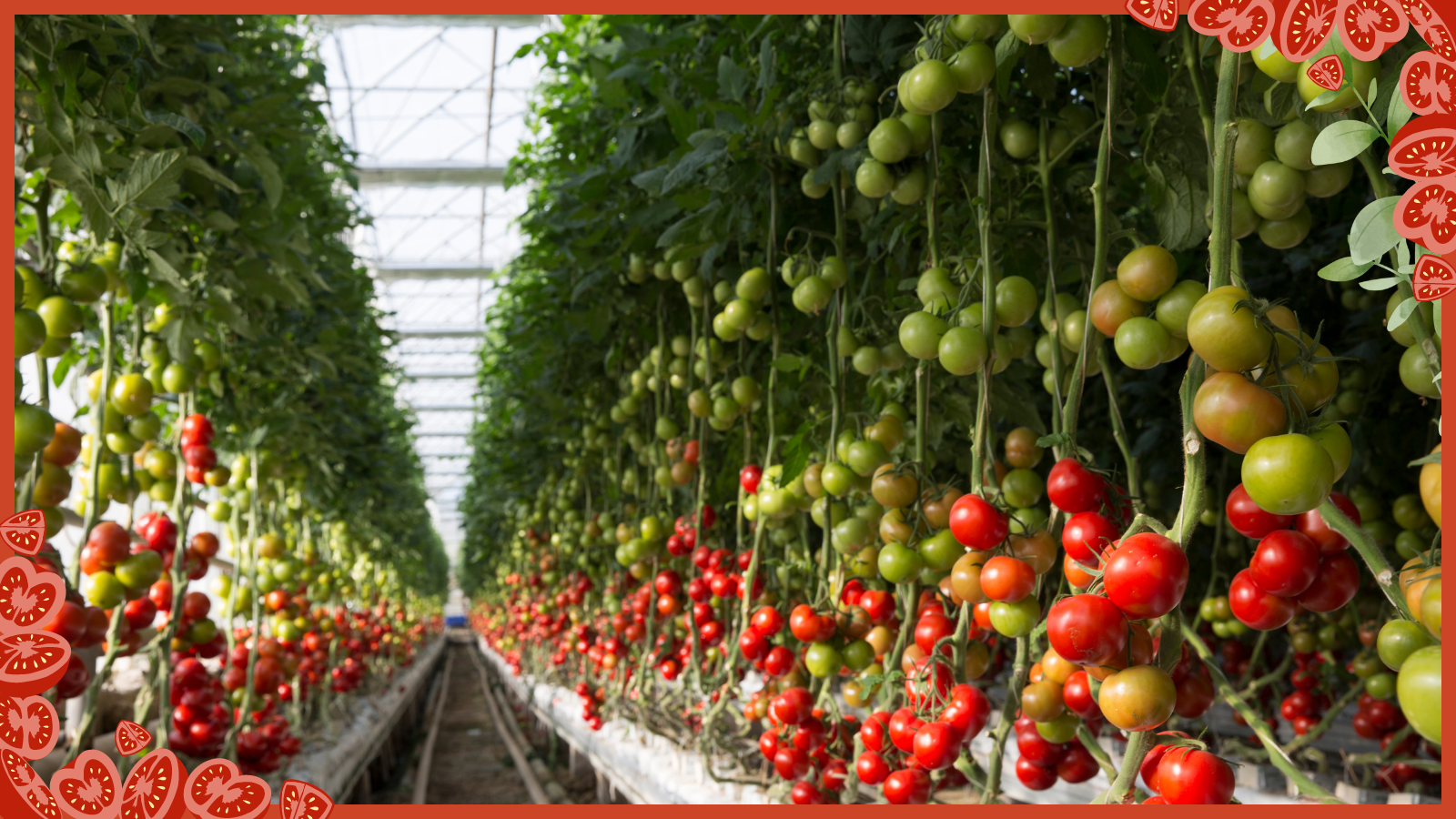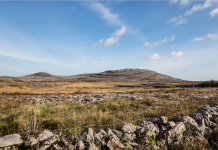Written by: Geoffrey Holland
“At the current rate of loss, some 12 million hectares of agricultural land per year are rendered useless, an area equivalent to the arable land of Germany, Poland, or Ethiopia.”
Phillip Lymbery, Sixty Harvests Left
Early in the 21st Century, the way the industrialized world produces food has no resemblance to ‘Old McDonald’s Farm’. The way humans feed themselves is massively out of balance with our planet’s ability to provide. At the current rate of soil loss, our Earth may only have sixty harvests left. It doesn’t have to be that way.
Imagine a world in which no animals have to suffer and be slaughtered so humans can eat. Imagine a new way of being in which the most basic fruits and vegetables are produced locally in every community in buildings that are designed to grow crops cost-effectively with little or no environmental consequences. In fact, that is where our world is headed.
“Saving our planet, lifting people out of poverty, advancing economic growth… these are one and the same fight. We must connect the dots between climate change, water scarcity, energy shortages, global health, food security and women’s empowerment. Solutions to one problem must be solutions for all.”
Ban Ki-Moon, Former UN Secretary-General
Our Current Food Reality
It starts with the sheer number of mouths that need to be fed. In just the past 100 years, the human population has quadrupled in size from 2 billion to over 8 billion. Every additional person added to the population, at a minimum, requires food, water, and shelter to survive.
Since our beginnings, humans have had an unchallenged sense of entitlement where nature is concerned. It’s been ‘take, take, take’ without any concern for consequence. Until recent decades, there weren’t enough humans on Earth to have any lasting consequences. Now that there are eight billion plus humans on Earth, on the way to 10 or more billion in the next few decades, the ways we exploit our planet’s living resources have evolved in an entirely unsustainable fashion.
Early in the 21st Century, about 50 percent of our Earth’s arable land is dedicated to producing food. Of that agricultural land, 70 percent is set aside for livestock production— animals raised mostly for slaughter and processing into beef steak, pork cutlets, chicken nuggets, lamb chops, and such.
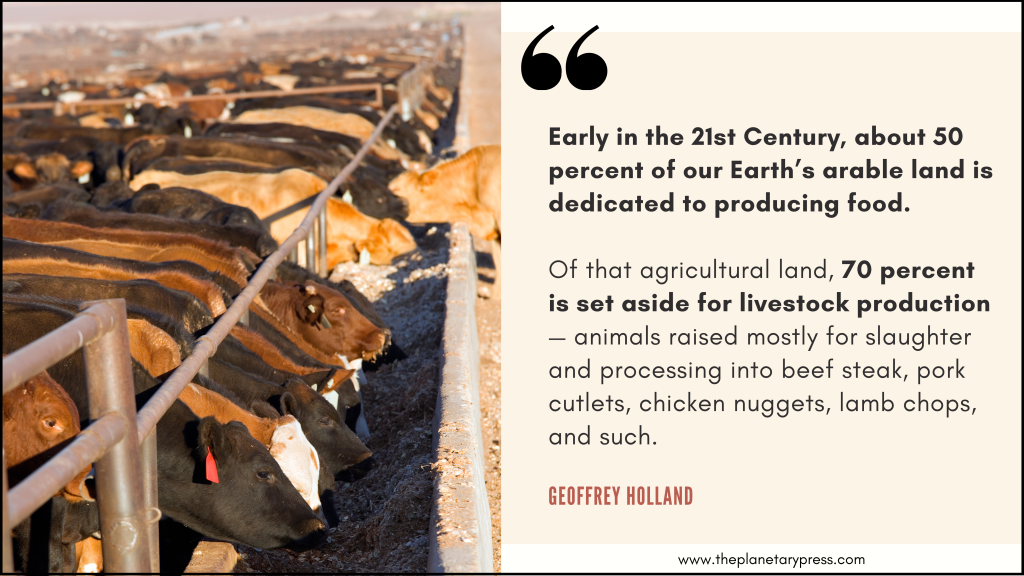
Given the huge increase in the number of humans that need to eat, particularly in recent decades, the era of our food coming from family farms is long gone. Most of what humans eat now is produced on a massive industrial scale. These days, food production is a very big business. In the U.S. alone, the food industry is worth nearly $1.2 trillion annually, almost six percent of the nation’s GDP.
“Part of what the food industry does with public relations, just like the chemical industry or the oil industry, is to try to erase their fingerprints from their messaging.”
Anna Lappe, author of Diet for a Hot Planet
What Does Industrial-Scale Animal Agriculture Look Like?
Consider cattle raised for slaughter. These days, from the moment of birth, these animals are confined in pens with other beef cattle of similar age. Cattle are ruminants. They are physiologically designed to graze on grass. Modern cattle raised industrially live in massive feedlots located all over the world. The object is to raise ‘the beef’ as quickly as possible.
They are fed a constant diet of grain, which they do not eat naturally and does not agree with their digestive process. The beef and dairy industries are major contributors to greenhouse gas emissions through their digestion and their waste. The methane cattle produce is up to 28 times more potent as a greenhouse contributor than carbon dioxide.
Feedlot cattle are crowded together in massive numbers, often with barely enough space to turn around. To minimize disease, cattle are regularly dosed with antibiotics. In fact, more than 70 percent of antibiotics worldwide are used in livestock agriculture. That reality seriously impacts the efficacy of those antibiotics on humans.
Cattle are living creatures reduced to an industrial commodity. The entire process from birth to ignominious slaughter is optimized to deliver, at low cost, a constant flow of beef steak and hamburger to markets across much of the world.
Similar horror stories go with the industrial production of pork and chicken. Even if one can get past the callousness and cruelty that goes with treating living creatures with such indifference, producing food this way is unsustainable for a whole range of reasons.
Here is one way to understand the scale of this kind of agriculture. In his book, Sixty Harvests Left, the distinguished author Phillip Lymbery identifies one Brazilian company that produces chicken, slaughtering as many as 14 million birds every passing day. Pause for a moment and think about what it takes in a day to serve up chicken for a large share of eight billion humans. A similar dynamic prevails across the world’s oceans. Industrial-scale trawlers, built to take massive volumes of marine life, are at work at any given moment on our Earth’s seas. The intent: slake the food demands of billions of humans who eat seafood. A broad range of fish, crustaceans, and other pelagic species have been reduced to human food commodities.
The fish catch from our oceans exceeds 100 million tons annually. In fact, according to the United Nations, 90 percent of our world’s ocean fisheries are already fully exploited.
Growing Crops Without Concern for Consequence
Like with animal agriculture, the object with growing field crops at industrial scale is to optimize yield at lowest cost.
There was once a time when field crops were intended primarily for human consumption. That was then, this is now… Now, almost half of the world’s cropland is used to grow cheap grain to feed livestock.
The industrial production of field crops goes from planting to crop harvest as quickly as possible. It requires the regular application of organic fertilizers and pesticides. It includes the use of large tilling and harvesting machines that guzzle fuel. It also demands the massive exploitation of available water resources. When cropland is managed this way, it quickly strips the natural fertility from the soil. Massive amounts of fertile soil are also lost to erosion when agriculture is tuned to maximizing the bottom line. In the U.S. Midwest alone, more than 57 billion tons of topsoil have been lost to erosion. The rate of erosion is estimated to be double what is sustainable.
“In one human lifetime, the planet has gone from being a bountiful Garden of Eden to a world in decline. At the center of this decline is the industrialization of agriculture…The key to transformation lies in a global agreement at the UN level to move away from industrial agriculture…”
Phillip Lymbery, Sixty Harvests Left
The Better Way Forward
A small number of people control the way food is produced, and the entire industry is encouraged by a broad range of interests with massive political influence. Shifting to a sustainable course for feeding humanity will happen only when the public recognizes the seriousness of the problem and comes together to demand a sustainable, economically viable new course in government agricultural policy.
Fortunately, where food security is concerned, there are a range of emerging technologies that are poised to transform the way humans eat.
Before getting on to perhaps the most important of these new ways of producing food, this writer would be remiss if he didn’t mention a simple fact; shifting the human culture to a largely plant-based diet would be the quickest and easiest step to correcting the cultural course on climate and assuring the food security of future human generations. The evidence is clear. Plant-based eating is not only far less costly, but it is also substantially more healthy, and it can be sustainable in ways the current agricultural model can never be. Consider an approach just now emerging, in which every community the world over can produce all of their basic vegetable and fruits locally, without concern for the climate-driven extreme weather that looms ominously.
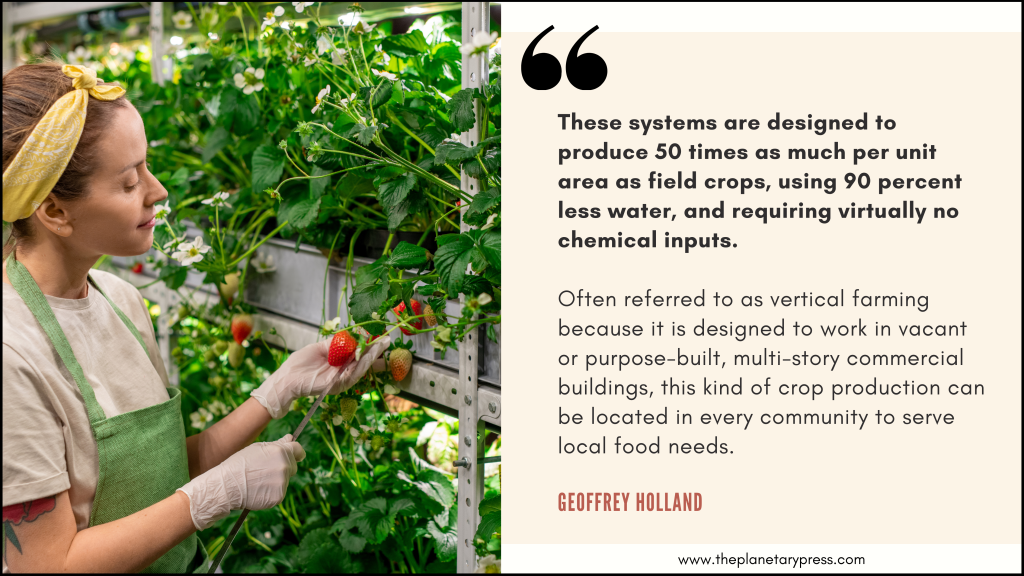
The Case for Vertical Farming
In a nutshell, this is a way of growing food crops like tomatoes, lettuce, celery, and onions in buildings specifically designed for crop production using advanced techniques that use renewably reproduced electricity to power artificial lighting optimized to encourage plant growth. These systems are designed to produce 50 times as much per unit area as field crops, using 90 percent less water, and requiring virtually no chemical inputs.
Often referred to as vertical farming because it is designed to work in vacant or purpose-built, multi-story commercial buildings, this kind of crop production can be located in every community to serve local food needs.
Because these vertical farms operate indoors, away from the weather, with staple crops suited to this kind of growing system, there can be multiple annual harvests. Many of these indoor farming technologies are aquaponic, which means the growing medium is water. They don’t require any soil.
Public policy around the world should encourage vertical farms in all cities and communities to provide food security. This will be particularly reassuring in an era of planetary-scale climate extremes.
One very appealing way to set up vertical farms is through citizen cooperatives, where local government shapes public policy to encourage community participation in the entire food production process.
For those who cannot get past their need for some kind of dietary animal protein, there is new technology on the horizon that will make many kinds of animal protein available on supermarket shelves at low cost, and with animal slaughter entirely removed from the process.
The Nature of Hi-Tech Cellular Agriculture
There is now a range of proven, cutting-edge technologies that take cell cultures from beef cattle, hogs, chickens, fish, and other high-nutrient animal sources and turn those tissue samples into a whole range of the equivalent of steak, cutlets, nuggets, and fillets. It will be done on a very large scale in factories that could be widely dispersed so the food products they make can be located close to every community market across the Earth.
Cellular agriculture may sound like a pipedream. It is real and likely will begin to replace meat products that come from slaughterhouses by the end of the decade. The same kind of technology is being adapted to produce the equivalent of dairy products and eggs. Yes, it does sound too good to be true. Scout’s honor: It’s real. It’s proven. It’s close at hand.
Moreover, this emerging cellular agriculture technology is the remedy for a very big planetary-scale challenge, a challenge that was the focus of the late great biologist E. O. Wilson. He said the biggest threat to life on Earth was the loss of biodiversity caused by humans taking nearly all of the planet’s arable land for themselves. In order to protect precious biodiversity, Wilson created the Half-Earth Project. He knew the only place to find half our planet’s fertile land that could be returned to nature would be from agriculture, particularly the kind dedicated to raising livestock. Think about what would happen if a very big share of the land, now heavily laced with livestock, were given back to nature.
If the reader would like to learn the whole story of our evolving food technology, the go-to source should be Sixty Harvests Left by Phillip Lymbery. It’s a best-seller. It’s gotten all kinds of accolades, including the following from a celebrated voice for nature.
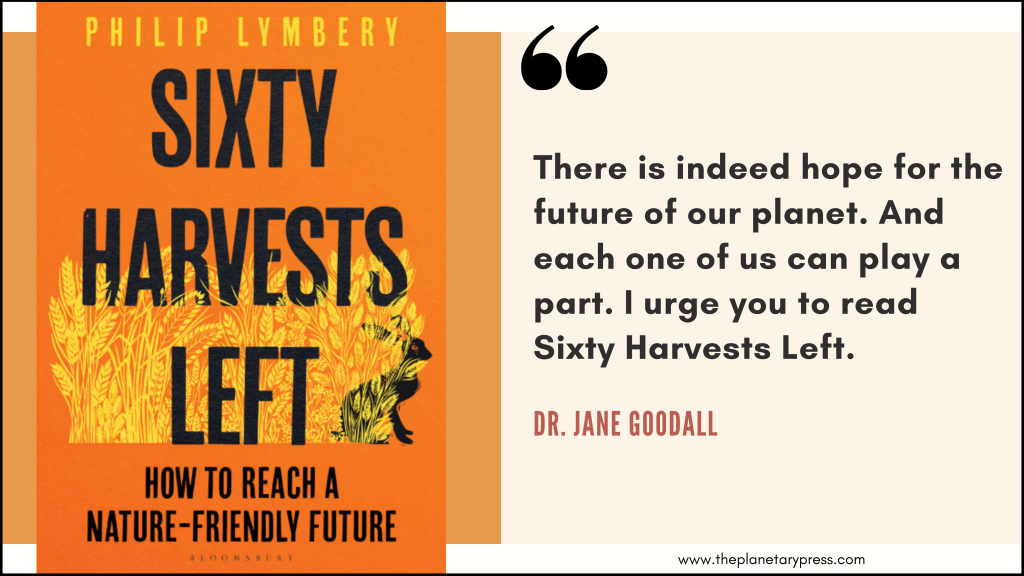
Being Human in this Emerging Era of Limits and Shared Possibility
It’s reassuring that we have blossoming technologies, not just for producing food in a nature-friendly, environmentally restorative way but also for putting our human cultural course on a worthy path going forward.
The road to a better way of being human starts with recognizing that we are all in this struggle for survival together. Make no mistake. Given the cultural dysfunction that currently prevails, the future of life on Earth is very much at risk of something like planetary-scale collapse. Fixing that starts with the social media giving that message adequate attention.
Humans are the most consequential species on Earth. A thing we must all do is get past our sense of entitlement, the attitude that all of the natural world, land and sea, was put here for our exploitation. In fact, there are worthy answers for our most vexing challenges. First, we must get past our long history of self-interest and understand that proper care of our Earth’s biodiversity is something we all need to prioritize.
The good news is we humans are linked together like never before. We have the ability to stand behind a common commitment to each other and to the natural world we all depend on.
More than anything else at this moment, we humans need to come together and embrace common purpose…the kind of common purpose that will elevate us to being the best version of humanity we can be.
“If you look at Earth from space you see a dot, that’s here. That’s home. That’s us. It underscores the responsibility to deal more kindly and compassionately with one another and to preserve and cherish that pale blue dot, the only home we’ve ever known.”
Carl Sagan, Voice of the Cosmos

